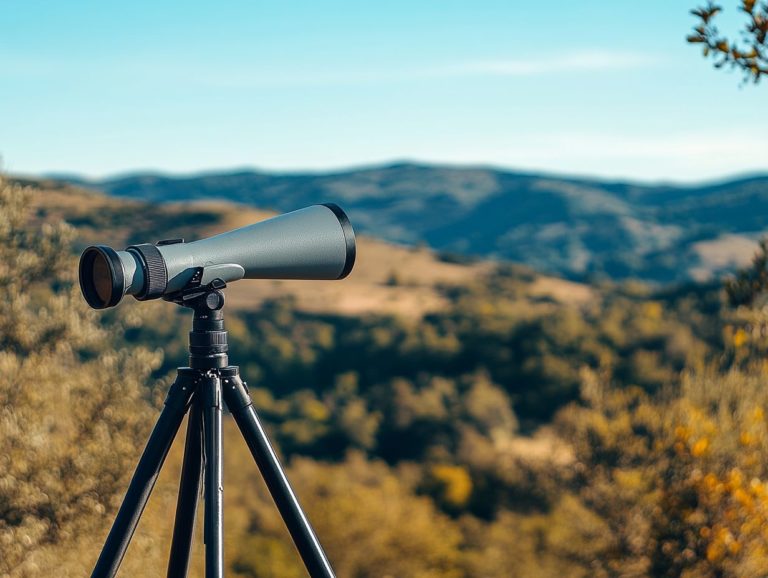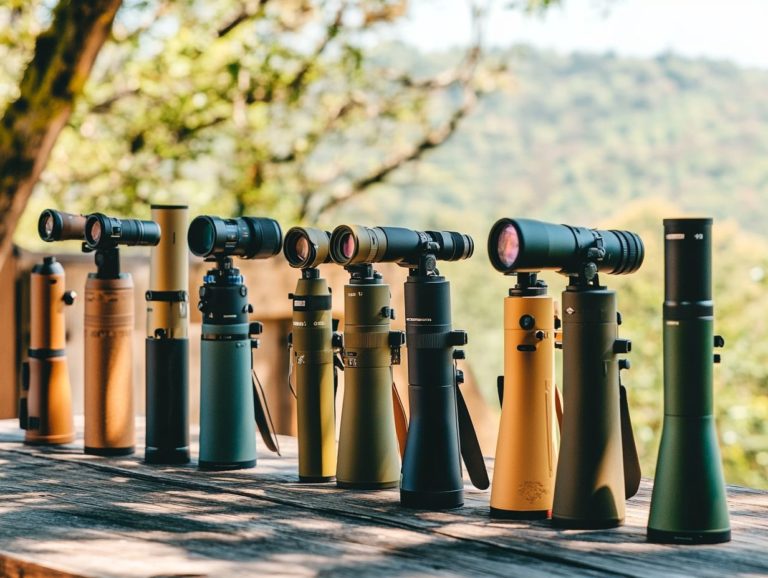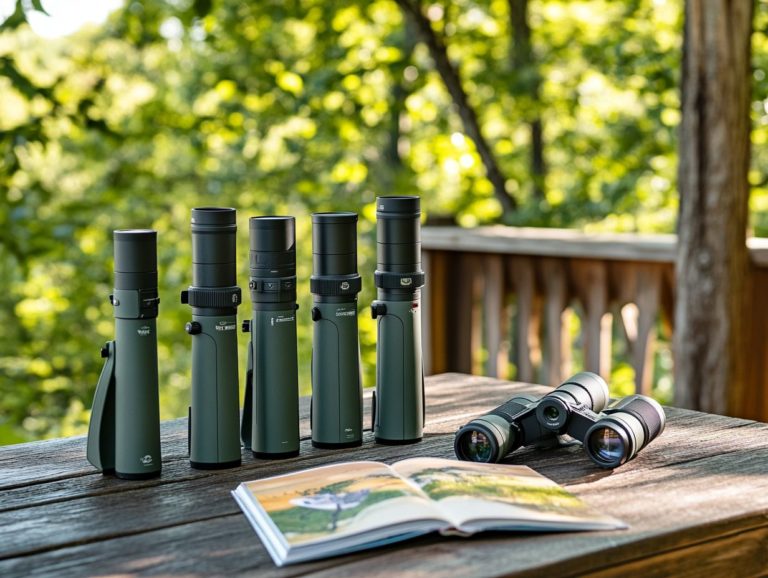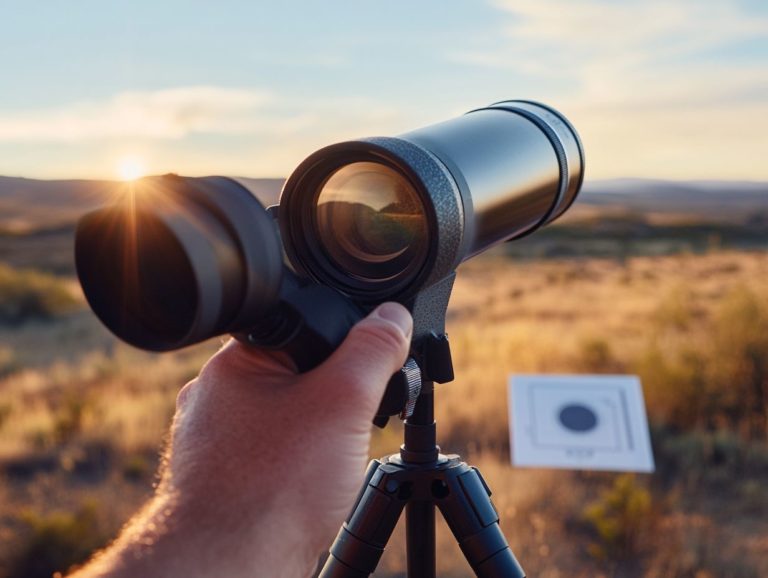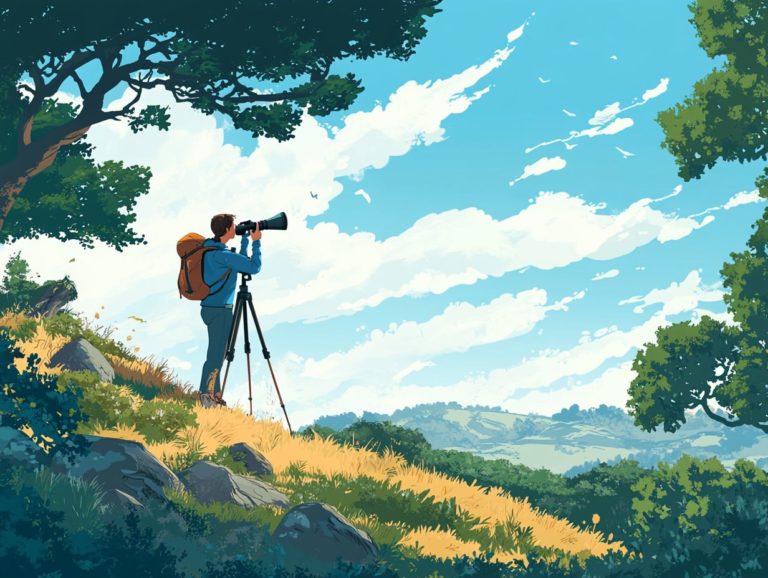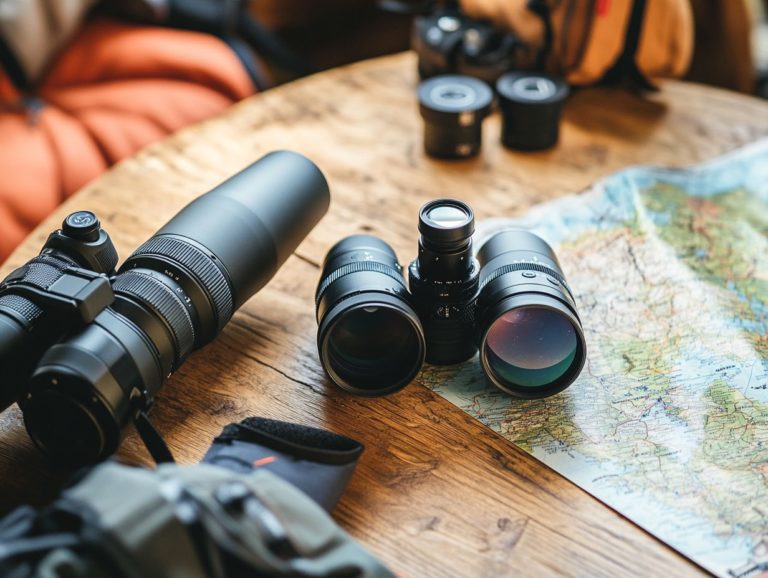5 Most Common Spotting Scope Problems and Solutions
Spotting scopes can truly elevate your outdoor experience, whether you re birdwatching, hunting, or gazing at the stars.
However, like any piece of equipment, they come with their own set of challenges. Issues such as blurred images or mounting difficulties can detract from your enjoyment and effectiveness in the field.
Get ready to explore the five most common spotting scope problems and unlock practical solutions! You ll discover tips on maintenance, troubleshooting, and how to sidestep common pitfalls, ensuring your scope performs at its peak.
Immerse yourself in this guide and unlock the full potential of your spotting scope!
Contents
- Discover Key Takeaways:
- 1. Blurred or Distorted Image
- 2. Inability to Focus
- 3. Poor Quality Optics
- 4. Difficulty with Mounting or Stability
- 5. Limited Field of View
- How to Properly Clean and Maintain Your Spotting Scope?
- What Are the Different Types of Spotting Scope Mounts?
- What Are the Most Common Causes of Spotting Scope Malfunctions?
- How Can You Troubleshoot and Fix Common Spotting Scope Problems?
- What Are Some Tips for Improving the Quality of Your Spotting Scope?
- What Are Some Common Mistakes to Avoid When Using a Spotting Scope?
- Frequently Asked Questions
- What are the 5 most common spotting scope problems?
- What causes blurry images in a spotting scope?
- How can I prevent my eyepiece from fogging up?
- What should I do if my spotting scope lens gets scratched?
- How do I fix misaligned optics in my spotting scope?
- Why am I having difficulty focusing with my spotting scope?
Discover Key Takeaways:
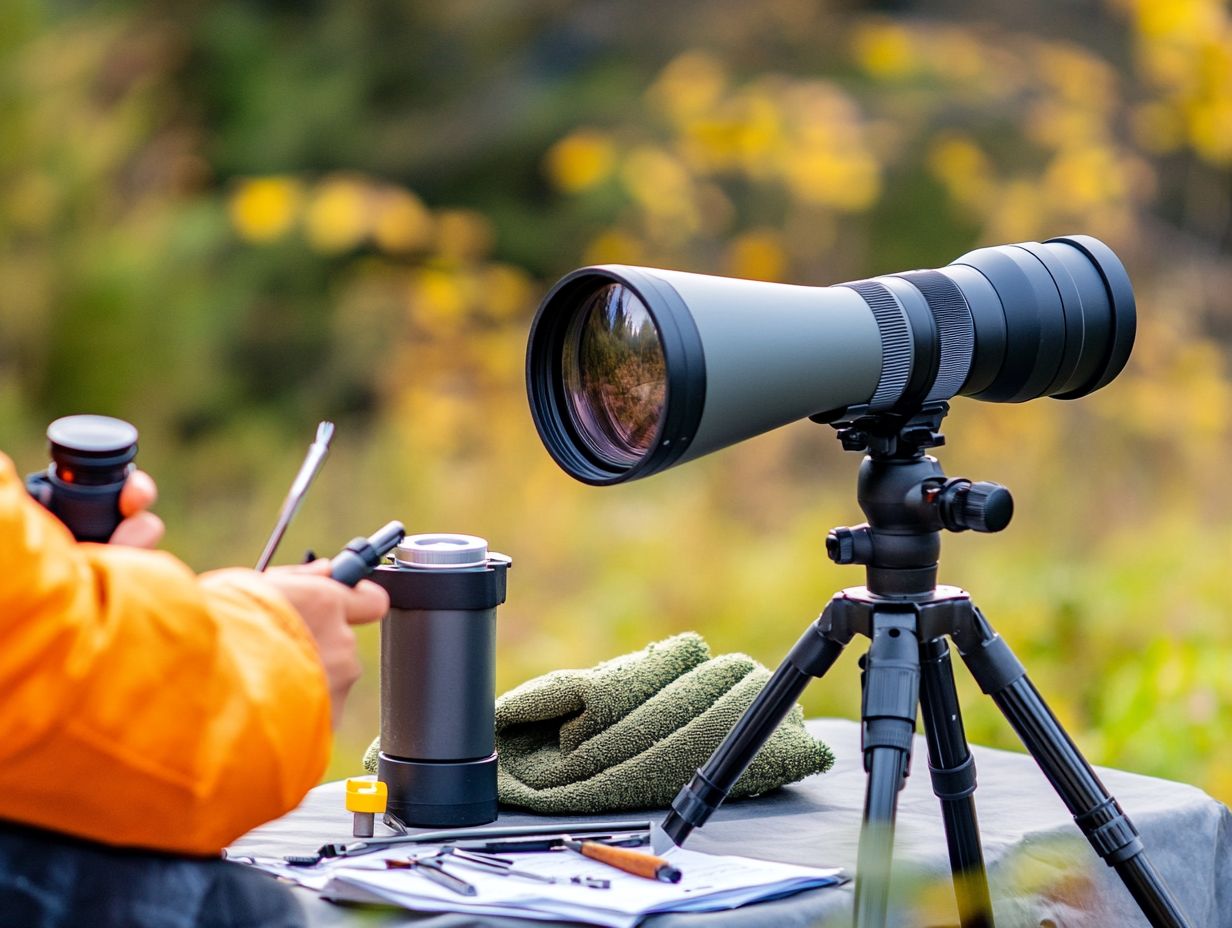
- Blurred images? Check for dirty lenses or make sure your eyepiece is adjusted correctly.
- Struggling to focus? Follow the manufacturer’s instructions and use a tripod.
- Images lack clarity? Invest in high-quality optics and keep them clean.
1. Blurred or Distorted Image
A blurred or distorted image can be one of the most frustrating setbacks when using a spotting scope especially for birding and wildlife observation. It can seriously detract from your enjoyment of nature’s splendor and ruin your chances of capturing breathtaking photography.
To tackle this issue effectively, high-quality optics, superior lens quality, and proper adjustments are essential. One common culprit behind blurred images is the improper adjustment of the eyepiece. Neglecting to fine-tune this crucial component can severely hinder clarity, leading to irritation during those pivotal moments of observation.
Subpar lens quality can also cause distortion, negatively affecting your overall viewing experience. When choosing a spotting scope, it s wise to consider waterproof features, particularly if you’re planning to navigate unpredictable weather. Investing in a scope with a larger objective size can also enhance your light-gathering abilities.
User reviews on platforms like Amazon can be invaluable, offering insights that help you make informed decisions about high-quality scopes capable of performing well in a variety of conditions.
2. Inability to Focus
Inability to focus can be a considerable hurdle when you re using a spotting scope, especially during wildlife viewing and birding. It can rob you of the joy of savoring nature’s intricate details and capturing those perfect photographic moments.
Several factors can lead to these focus challenges, with low light conditions being a major troublemaker. When the light dims, your ability to gather enough brightness wanes, making it tough to clearly see the fine features of distant subjects. This is where the quality of optics and extra-low dispersion glass become critical.
Properly adjusting the eyepiece is essential for achieving optimal clarity. You may discover that investing in high-quality spotting scopes with a large objective lens significantly elevates your focusing experience, offering sharper images and better light transmission.
This way, the beauty of nature remains vivid and accessible even in less-than-ideal lighting.
3. Poor Quality Optics
Poor quality optics can seriously hamper your experience with a spotting scope. It makes observing wildlife and birds in their natural habitat tough especially in stunning locales like the Great Smoky Mountains.
However, having the right optics is nothing short of remarkable. High-definition (HD) optics and Fluorite glass redefine clarity, allowing you to see every intricate detail of a feather and each vibrant color with stunning precision. This truly enhances every viewing experience.
Coated lenses minimize glare and maximize light transmission, contributing to this brilliance. Meanwhile, ED (Extra-low Dispersion) glass, which reduces color fringing, helps create sharper images that captivate the eye.
Brands like Vortex Optics, Celestron, and Gosky offer cutting-edge technology that enhances both your birding and photography adventures. They deliver crisp images that make the natural world spring to life, whether you’re capturing a fleeting moment or simply soaking in the scenery through your lens.
4. Difficulty with Mounting or Stability
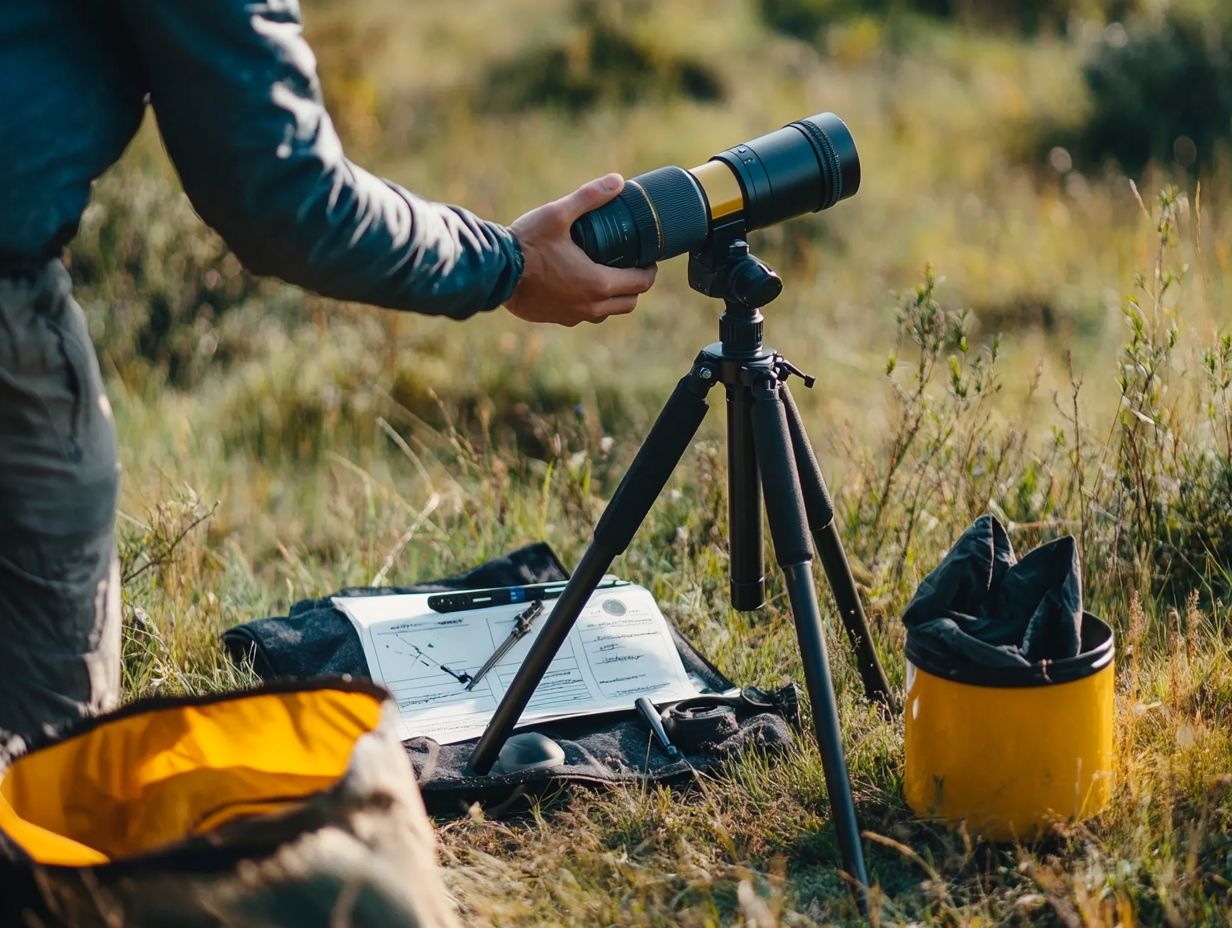
Struggling to mount or maintain tripod stability can affect your experience with a spotting scope. This is especially true during long hours of wildlife viewing or birdwatching when a stable image is essential for appreciating nature’s beauty.
Choosing the right tripod is crucial; it acts as your steadfast support system. A robust tripod captures every detail without the annoyance of shaky or blurred views. When selecting a tripod, consider the weight of your spotting scope. A heavier setup can complicate portability.
Aim for a tripod that balances stability and manageable weight for easier transportation during lengthy outings. Investing in a comfortable carry solution, like a padded strap or a compact backpack, can elevate your overall experience.
This way, you can set up your scope swiftly and efficiently, minimizing downtime and maximizing your time in the field vital for wildlife viewing.
5. Limited Field of View
A limited field of view in a spotting scope can dampen your wildlife viewing and birding experience. It turns the thrill of tracking fast-moving subjects into a frustrating endeavor and makes it tough to appreciate expansive landscapes.
Understanding the relationship between magnification and field of view is essential for spotting wildlife effectively. Higher magnification may seem appealing, but it often narrows your field of view, making it challenging to locate and follow animals in their habitats. This is where the magic of objective size and light-gathering capabilities come in!
A wider field of view opens up larger observation areas, making it easier to track unpredictable movements. Consider your preferred viewing scenarios; for example, lower magnification is perfect for sweeping open landscapes, while moderate magnification is better for focused birdwatching.
By choosing a scope that strikes the right balance between these two factors, including objective lens and adjustable lens, you can elevate your viewing experience and immerse yourself more fully in the captivating beauty of nature. Don’t miss out on capturing those stunning moments!
How to Properly Clean and Maintain Your Spotting Scope?
Proper cleaning and maintenance of your spotting scope are essential for preserving the quality of your optics and ensuring a clear, sharp image during your birding and wildlife observation adventures. This is crucial for optimal performance.
Regular upkeep not only extends the lifespan of your device, but also significantly elevates your viewing experiences. Use a microfiber cloth lightly dampened with distilled water or lens cleaning solution to prevent scratches. Gently wipe in a circular motion to eliminate smudges and dust without harming those delicate surfaces. Keeping your optics free from dirt accumulation is crucial.
Regular inspections every few months can work wonders! Look for signs of dust accumulation or moisture buildup. Consider seasonal deep cleans, which may involve disassembly, to maintain optimal performance especially if you frequently use your scope in a variety of environments and conditions.
What Are the Different Types of Spotting Scope Mounts?
Understanding the various types of spotting scope mounts is essential for achieving maximum tripod stability and ease of use during your birding and wildlife viewing adventures. Knowing about different mounts helps your optics perform their best.
Choosing the right mount can significantly enhance your viewing experience by providing features tailored to your specific activities. For example, ball heads allow for flexible angles during photography, while pan-tilt heads are perfect for smooth tracking of moving subjects. Each mount type contributes uniquely to the overall stability of your spotting scope, minimizing vibrations and ensuring crisp, clear images.
If you re a digiscoping enthusiast using a digital camera with a scope to take photos you might need specialized mounts that accommodate smartphone attachments. This allows you to capture clear images without sacrificing steadiness. Selecting the right mount based on your individual needs not only boosts performance but also elevates your enjoyment of outdoor activities, including wildlife observation.
What Are the Most Common Causes of Spotting Scope Malfunctions?
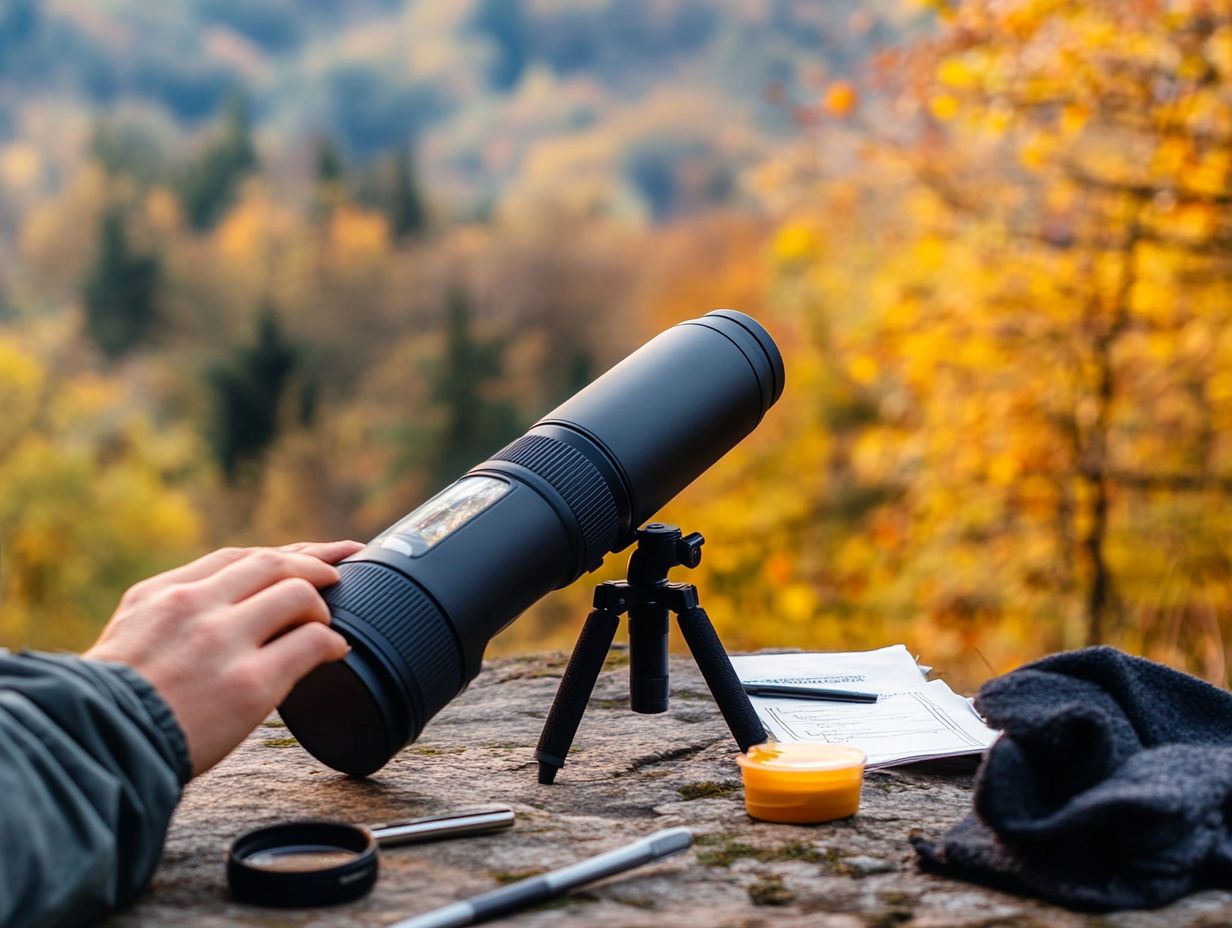
Common causes of spotting scope malfunctions often stem from issues with optics quality, improper adjustments, and environmental factors. All of these can diminish your overall viewing experience in nature. To enhance your understanding, consider checking out 5 things you didn’t know about spotting scopes. Analyzing Amazon reviews can help identify potential problems before they arise.
For instance, if the optical components are misaligned, you may struggle to focus and achieve that crystal-clear image you desire. Similarly, inadequate mounting can introduce vibrations that compromise stability, making your observations less enjoyable particularly with heavy scopes.
By understanding these specific issues, you can take proactive steps to enhance your experience. Regularly calibrating your equipment and ensuring that mounts are secured correctly can make a significant difference. Performing routine checks for loose parts and keeping your scope clean will also help maintain optimal performance.
Understanding how your spotting scope works can help you avoid common issues. To enhance your experience, check out these tips for using spotting scopes in low light and make sure you’re ready to capture every breathtaking moment in the great outdoors!
How Can You Troubleshoot and Fix Common Spotting Scope Problems?
Troubleshooting and fixing common spotting scope problems is vital for maintaining optimal performance. Additionally, exploring ways to enhance your spotting scope experience allows you to enjoy birding and wildlife observation without interruptions.
When issues arise like blurred images or focusing difficulties address them promptly to greatly enhance your viewing experience. Start by checking the eyepiece and objective lenses for dirt or smudges. Even minor debris can significantly impair clarity. A microfiber cloth is your best friend here, easily eliminating obstructions without scratching that precious glass.
If the problem persists, ensure that the focusing mechanism—the part you turn to make things clearer—is functioning smoothly and isn’t stuck or misaligned. Regular cleaning and occasional recalibration of the scope can help prevent future issues. Additionally, consider the unique features in high-end spotting scopes that might enhance your experience. Store the scope in a protective case when not in use to shield it from environmental factors that could lead to deterioration.
What Are Some Tips for Improving the Quality of Your Spotting Scope?
Improving the quality of your spotting scope focuses on a few key elements: selecting high-quality optics, diligently maintaining your equipment, and employing the right techniques for observing wildlife and birding.
Start by investing in top-tier lenses; this choice can dramatically enhance clarity and brightness, allowing distant subjects to come into sharper focus. Equally crucial is adopting rigorous maintenance habits, such as regularly cleaning the lenses and inspecting for potential damage. This helps ensure your equipment lasts longer.
Familiarizing yourself with your scope s specific capabilities like its magnification range and field of view gives you the power to maximize your viewing experience. By integrating these strategies, you not only enjoy sharper images but also nurture a deeper connection with nature, fully immersing yourself in the beauty that surrounds you.
What Are Some Common Mistakes to Avoid When Using a Spotting Scope?
Avoiding common mistakes when using a spotting scope can significantly elevate your wildlife viewing and birding experiences. To enhance your knowledge, check out these weird facts about spotting scopes. This allows you to appreciate the beauty of nature with remarkable clarity and precision.
Many users often fail to adjust the scope for their specific viewing conditions, resulting in less than ideal results. Another common oversight is neglecting routine maintenance, which can undermine the optical performance over time.
To sidestep these issues, make the necessary adjustments to focus and stabilize the device according to the light conditions and distance. Regularly clean and check the components to ensure the scope remains in peak condition.
By adhering to these best practices, you can truly unlock the full potential of your equipment, enhancing your journey as an aspiring birdwatcher or nature enthusiast.
Watch this video for more tips on troubleshooting spotting scopes:
Frequently Asked Questions
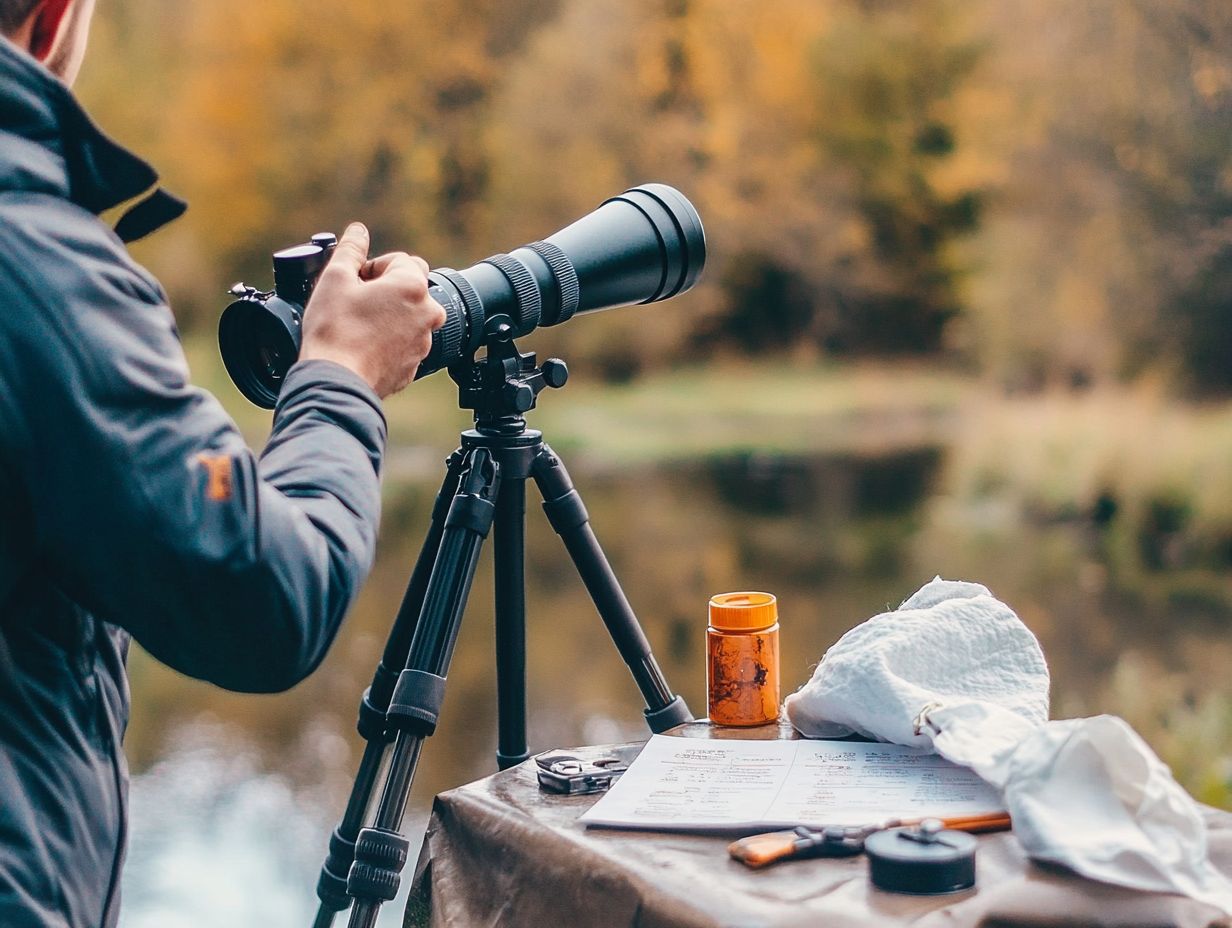
What are the 5 most common spotting scope problems?
- Blurry images
- Eyepiece fogging
- Lens scratches
- Misaligned optics
- Difficulty focusing
What causes blurry images in a spotting scope?
Blurry images are usually caused by a dirty lens or incorrect focus. Clean the lens and adjust the focus until the image is clear.
How can I prevent my eyepiece from fogging up?
To prevent eyepiece fogging, use an anti-fog solution or keep the scope in a dry and cool place when not in use. You can also use a lens cap to cover the eyepiece when it s not in use.
What should I do if my spotting scope lens gets scratched?
If your lens gets scratched, it may affect the image quality. Consider trying a lens repair kit for a quick fix or taking it to a professional for repair. Properly storing and handling the scope will help prevent future scratches.
How do I fix misaligned optics in my spotting scope?
If the optics in your spotting scope are misaligned, you may need to take it to a professional for repair. This can also be caused by dropping or mishandling the scope, so it s essential to handle it with care.
Why am I having difficulty focusing with my spotting scope?
Having trouble focusing? Several factors could be at play, like adjusting the eye part of the scope, using a shaky tripod, or lighting conditions.
Make sure to adjust the eyepiece correctly. Use a sturdy tripod and test the focus in different lighting to find what works best for your target.

